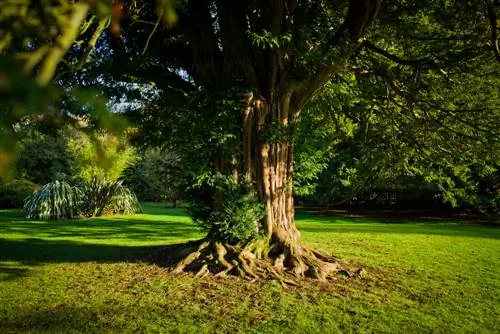- Author admin [email protected].
- Public 2023-12-16 16:46.
- Last modified 2025-01-23 11:20.
The real or columnar cypress (Cupressus sempervirens) is typical of the Mediterranean region, especially Tuscany. For this reason, the evergreen tree is sometimes called Italian cypress. In contrast to the very similar false cypress, the columnar cypress is not completely frost-hardy, which is why planted specimens can freeze to death in harsh winters.

What are the roots of a columnar cypress like?
Columnar cypresses (Cupressus sempervirens) are shallow-rooted plants whose roots remain close to the surface but can spread widely, sometimes searching deeper for water. Damage to flooring and water pipes can occur if the roots grow too close to the surface.
Columnar cypresses have shallow roots
In their homeland, columnar cypresses are considered real pioneer plants that can grow in almost any soil. The trees belong to the so-called shallow-rooted species, i.e. H. the roots remain close to the surface, but spread quite widely. It is important to be careful here, because the shallow root system can cause damage to floor coverings (e.g. paved sidewalks, etc.). In search of water, some roots also penetrate deeper into the ground, which is why cypress trees should not necessarily be planted directly above water pipes, drainage or similar - the fine hairy roots can penetrate the pipe systems and destroy them. How deep the roots actually reach depends on the one hand on the nature of the soil (in heavy soils roots tend to stay on the surface, in sandy ones they go deeper), but on the other hand also on the water supply.
Removing a tree stump from a Mediterranean cypress
You have a columnar cypress in your garden but want to get rid of it? There are several options for this: Of course, you can simply saw down the tree and dig out the roots. However, the following methods cause significantly less work (and also less destruction):
- Saw off the tree and use the tree slice as a saucer, for example for flower pots or boxes etc. You can sow wonderful annual, perhaps overhanging summer flowers there and create visual variety in the garden.
- Don't saw the tree just above the ground, but rather quite a bit above it. Use the stump as a climbing aid, for example for rambler or climbing roses or other climbing plants.
- Saw the tree just above the ground and simply place various young plants (e.g. brown cranesbill, the ground cover grows almost everywhere) around the tree disc. Over time, this will become decorative and overgrown.
- Saw the tree just above the ground and simply let the stump rot naturally. You can support this process by cutting the stump criss-cross with a saw and repeatedly adding rotting compost into the resulting gaps.
Tip
Similar-looking but guaranteed winter-hardy alternatives for the columnar cypress are the dark green columnar yew, the grey-green heather juniper or the likewise columnar thuja (tree of life).






